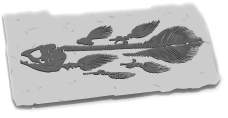|
True
Coelacanths are found in the fossil record as far back as 400
million years ago and even survived an earlier mass extinction
245 million years ago, yet fossils younger than 66 million
years have never been found, for reasons that remain unclear.
It's possible that following the Cretaceous-Tertiary
extinction that wiped out the dinosaurs, coelacanths took up
new habitats, like those found in the Comoros, that are not
conducive to fossilization; the steep underwater slopes of
these volcanic islands prevent the buildup of sediments that
would normally lead to fossilization.
|

|

|

